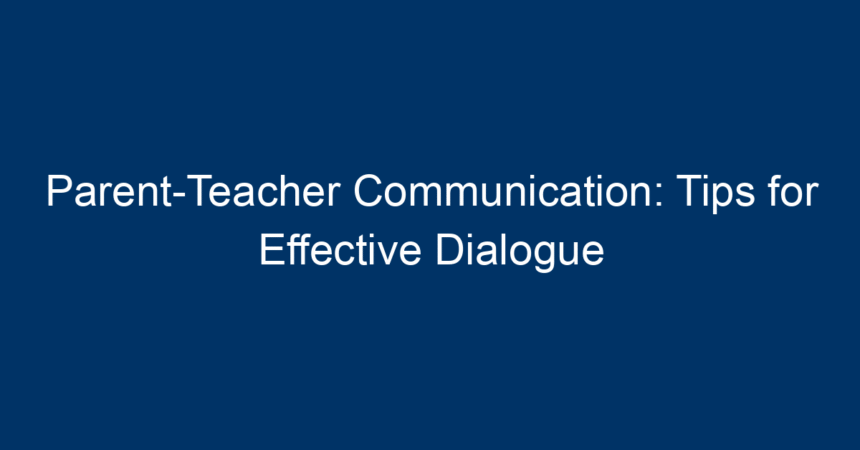Effective parent-teacher communication is essential for fostering a supportive environment for students. In today’s increasingly complex educational landscape, building strong partnerships between parents and educators can enhance student success and well-being. This article explores practical tips for creating open and constructive dialogue between parents and teachers, ensuring that all parties are aligned in their goals for the student.
The Importance of Parent-Teacher Communication
Parent-teacher communication serves as the backbone of a child’s educational experience. Strong collaboration ensures that both parents and teachers are on the same page regarding a student’s progress, needs, and areas for improvement. Research indicates that when parents engage actively in their child’s education, it correlates with improved academic performance and better social skills.
Benefits of Effective Communication
-
Building Trust: Open lines of communication foster mutual respect and trust between parents and teachers. This relationship helps create a safe space for discussing sensitive topics.
-
Better Understanding of Student Needs: Parents can share insights about their children’s strengths and weaknesses, allowing teachers to tailor their approaches to individual learning styles.
- Enhanced Student Engagement: When parents are involved, students feel more supported and motivated, boosting their confidence and academic achievement.
Strategies for Improving Parent-Teacher Communication
Effective communication is not just about exchanging information; it’s about creating meaningful dialogues. Here are several strategies to enhance parent-teacher communication.
1. Utilize Technology Wisely
In today’s digital age, leveraging technology can greatly enhance parent-teacher communication.
-
Email Updates: Use email to send newsletters, important announcements, and personalized updates. This ensures that parents are informed about their child’s progress and school events.
-
Communication Apps: Platforms like ClassDojo and Remind facilitate real-time dialogues. These apps allow teachers to send updates directly to parents’ phones, fostering immediate and ongoing communication.
- Virtual Meetings: Video conferencing tools like Zoom or Google Meet offer flexibility for parent-teacher conferences, especially for busy parents. It eliminates barriers of transportation and time constraints.
2. Schedule Regular Check-ins
Establish a routine for checking in with parents. Regular communication can help prevent small issues from escalating into larger problems.
-
Progress Reports: Send out personalized progress reports that highlight academic strengths and areas that need improvement. This encourages proactive discussions between parents and teachers.
- Parent Workshops: Organize workshops or information sessions to educate parents on the curriculum and academic expectations. These events help parents feel more connected to their child’s education.
3. Encourage Two-Way Communication
Effective parent-teacher communication is not a one-sided approach. Encouraging parents to share their insights and concerns fosters a collaborative environment.
-
Feedback Forms: Distribute short surveys or feedback forms to gather parents’ perspectives on school events or their child’s academic performance. This gives parents a voice and encourages them to contribute to their child’s education actively.
- Open-Door Policy: Teachers should encourage parents to reach out anytime they have questions or concerns. An open-door policy demonstrates that you value parents’ input and build trust in the relationship.
4. Use Positive Reinforcement
Recognizing and celebrating student achievements reinforces the positive aspects of parent-teacher communication.
-
Celebrate Successes: Send positive notes or emails home when a student excels or shows improvement. This not only boosts student morale but also strengthens the bond between parents and teachers.
- Highlight Collaborative Efforts: Share how parental involvement has positively impacted the classroom. This encourages more parents to participate actively.
5. Be Culturally Sensitive
Every family comes from unique cultural and educational backgrounds. Being sensitive to these differences can significantly improve parent-teacher communication.
-
Language Accessibility: Provide communication in multiple languages, if applicable. This makes parents feel included and valued, regardless of their primary language.
- Cultural Awareness: Understand and respect different cultural norms. This builds rapport and allows for more meaningful conversations about student needs.
6. Maintain Professionalism
While establishing a friendly rapport is important, maintaining professionalism is key to effective parent-teacher communication.
-
Set Clear Boundaries: Clearly communicate what parents can expect regarding response times and communication methods.
- Stay Objective: When discussing a student’s challenges, focus on facts and observations rather than personal opinions. This keeps the conversation productive and constructive.
Overcoming Common Communication Barriers
While implementing these strategies, it’s vital to acknowledge and address potential obstacles to effective parent-teacher communication.
1. Time Constraints
Many parents juggle work and family obligations, making it challenging to engage with teachers regularly.
- Accommodate Parent Schedules: Offer flexible meeting times, including early morning or late evening options.
2. Lack of Understanding
Some parents may feel intimidated or confused by educational jargon.
- Simplify Communication: Use clear, accessible language and avoid educational jargon in updates or discussions.
3. Emotional Responses
Discussions about a child’s performance can evoke strong emotions.
- Practice Active Listening: Make an effort to listen to parents’ concerns without interruption. Validating their feelings can lead to a more constructive dialogue.
Conclusion: Making Communication a Priority
In conclusion, effective parent-teacher communication is paramount in creating an enriching educational experience for students. By embracing technology, scheduling regular check-ins, promoting two-way conversations, using positive reinforcement, being culturally sensitive, and maintaining professionalism, educators can foster strong partnerships with parents.
Actionable Insights for Parents and Teachers
-
Parents: Make it a point to initiate communication with your child’s teacher regularly. Ask questions and share relevant information concerning your child’s home life or learning preferences.
- Teachers: Take the initiative to reach out to parents with positive feedback and constructive updates on their child’s progress.
Ultimately, prioritizing effective parent-teacher communication not only supports a child’s educational journey but also builds a vibrant school community. When parents and teachers unite, everyone benefits, most importantly, the students themselves.




